 IAS on Facebook IAS on Facebook
 IAS on Instagram IAS on Instagram

|

IAS Aroid Quasi Forum
About Aroid-L
This is a continuously updated archive of the Aroid-L mailing list in a forum format - not an actual Forum. If you want to post, you will still need to register for the Aroid-L mailing list and send your postings by e-mail for moderation in the normal way.
|
Does anyone grow the real Anthurium hookeri?
|
From: ExoticRainforest <Steve at ExoticRainforest.com> on 2010.06.11 at 00:21:08(21096)
I
have been seeking a specimen of the real Anthurium hookeri for
years! Before you immediately respond and say yes, please look at the
photos and read the
descriptions in
this thread. The majority of plants
sold in Florida are not the true species known to science as Anthurium
hookeri. but instead a plant using the name as a
common name. This plant appears to be far rarer than many of us
believe. It is found largely in the windward islands of the Caribbean
but also in French Guiana and other countries including Venezuela.
I've talked several times to Joep Moonen in French Guiana about it and
he sees it rarely.
Few people
appear
to be able to
give a good reason why almost everyone in Florida thinks they are
growing Anthurium
hookeri in their yard when they are not. Well known IAS member and
commercial
aroid grower Denis
Rotolante in Homestead offered the best reason I have been able to
find, "As
many nurserymen down here know, Anthurium hookeri is a catch all name
applied
to all bird nest type Anthuriums regardless of true taxonomic origins."
Many of those hybrid plants sold in Florida appear to be more closely
related to
Anthurium
schlechtendalii or Anthurium plowmanii than to Anthurium
hookeri.
If
you believe
you are growing Anthurium hookeri and your plant matches the
photos and
information in this thread I know for certain there are other growers
that
want to
find it, including me!
The
first
two photo
shows a specimen of the true Anthurium hookeri photographed at
the
Missouri botanical Garden. Look closely at the leaves and veins.
One
of
the most
distinctive characteristics of the true Anthurium hookeri is it does
not
produce red berries as is commonly believed on the internet and many
plant forums. The berries of the true species are
white.
Virtually
all the information on
the Internet stating the berries are red is inaccurate. I even found
one noted garden showing a photo of an infructescence with red
berries. The plant
referred to in all the garden site posts appears to be one of the
common plants sold in Florida using the
name only as a common name and not referring to the true species..
The
next
distinctive
characteristic of Anthurium hookeri is the interprimary veins
are evenly spaced
similar to the rungs of a ladder. In
science this even spacing is known as the venation being scalariforme.
Another important
characteristic is a newly emerging leaf unfurls in a way that is not
seen in
other bird’s nest Anthurium species.
The unusual way the new leaves of Anthurium hookeri are
rolled
is known as being supervolute vernation and
are very unusual in most species. That term
indicates the new leaves possess coils
or folds in overlapping whorls.
Vernation refers to the arrangement of young leaf blades and
supervolute
vernation is to possess a convolute arrangement in the folding or
arrangement
of a newly emerging leaf blade with one margin (edge) of the newly
blade
emerging rolled inward toward the midrib and the opposite margin rolled
around
the midrib o the opposite leaf f in a manner similar to the coil at the
end of
a conch shell.
All
bird’s nest Anthurium, at least those that are members of Anthurium
section Pachyneurium, produce convolute new leaves. The
only
difference in supervolute and
convolute vernation is convolute vernation occurs when several leaves
spiral
with the next leaf in a module enclosed within the current leaf. I
realize this
is difficult to understand but look at the leaf in the photo as well as
the
diagram below. Look closely at the diagram of convolute vernation and
you will see the second leaf inside the first leaf which is common to
the way bird's nest forms unfurl. Anthurium hookeri is the
only exception according to Dr. Croat. Tom once indicated he felt
Anthurium hookeri could be in section Porphyrochitonium.
Another
very important characteristic is the real Anthurium hookeri has
tiny
black
dots, especially on the underside of the leaves. In science these
little black
dots are known as glandular punctates.
If you
have real species of Anthurium hookeri please post photos and
if you
know where specimens of your plant can be found please post that as
well.
There
are several other unique characteristics found only on Anthurium
hookeri and
not on the hybrid or miss named plants commonly sold in Florida. If you
want to
learn more the information can be read here:
href="http://www.exoticrainforest.com/Anthurium%20hookeri%20pc.html">http://www.exoticrainforest.com/Anthurium%20hookeri%20pc.html
The
scientific description of Anthurium hookeri is very simple; so
for anyone that
| HTML +More |
may doubt the accuracy of what I am trying to explain please take a few
seconds
to read the actual description.
A. hookeri
Kunth, Enum. pl. 3:74. 1841. Type: Schott Drawing 517 serves
as the lectotype (designated by Mayo, 1982)
Epiphyte.
Internodes short densely rooted; cataphylls lanceolate, 20-26 cm
long, dilacerating from base. VERNATION- supervolute; Leaves
rosulate; petioles triangular to D-shaped, 2-9 cm long, 1.5-1.7 cm
wide;
blades oblanceolate, broadest above middle, margins smooth, black
glandular punctates
on both surfaces, 35-89 cm long, 10-26 cm wide. Primary lateral
veins 9-15 per side, free to the margin, tertiary veins extending in a
more or less parallel, ladder-like fashion between the primary lateral
veins
(scalariform). peduncle to 47 cm long, to 5 mm dam.; spathe pale
green,
tinged purple, oblong, to 9 cm long, to 1.5 cm wide; spadix
violet-purple,
cylindroid-tapered, to 10-16 cm long, to 5-7 mm diam,; Infructescence-
berries,
obovoid, whitish, to 6 mm long, to 4.5 mm wide.
I really want to
find this plant so thanks
very much for any help!
Steve
www.ExoticRainforest.com
--------------030704030804050306020002 |
|
From: "John" <criswick at spiceisle.com> on 2010.06.11 at 16:59:53(21097)
Steve,
I
believe the true A. hookeri occurs on Trinidad.
This is according to what the late Dr. Richard Howard told me when we were collecting
in Grenada
| HTML +More |
together. He published the Flora of the Lesser Antilles.
The species we have in Grenada,
90 miles to the north, is A. wildenovii I believe, and I have never seen A.
hookeri growing here.
It
should not be difficult to obtain seeds and seedlings of A. hookeri in Trinidad
but the airline charges a ridiculous amount to get there from Grenada.
John.
From: aroid-l-bounces@www.gizmoworks.com
[mailto:aroid-l-bounces@www.gizmoworks.com] On
Behalf Of ExoticRainforest
Sent: Thursday, June 10, 2010 8:21
PM
To: Discussion
of aroids
Subject: [Aroid-l] Does anyone
grow the real Anthurium hookeri?
------=_NextPart_000_0072_01CB0965.FDC23060--
--==============�68474117938604240=� |
|
From: "Denis Rotolante" <denis at skg.com> on 2010.06.11 at 19:02:48(21098)
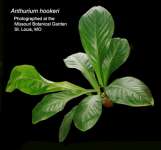
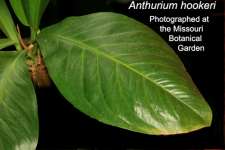
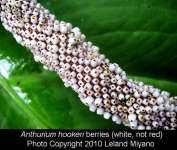
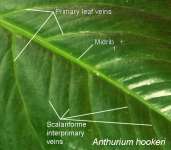

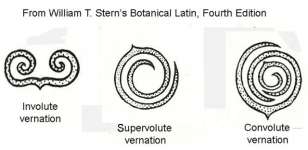
Steve:
I grew a crop of seeds froom my stock plant but nobody wanted any so I stopped growing them....there is too much confusion in our industry because growers, interiorscapers and landscapers are saying "Hooker" but they realy mean Pachyneurium Birdsnest types. Next time I have seeds, I'll send them to you and you can give them away to any one who needs them.
they are not Pachyneurium Group Birdsnest Anthuriums and are not as durable as some of the others but they grow just as easy. Got my mother plant from Dr.Tom at Mobot at a Aroid distribution. I haven't seen it lately, I guess I'll have to get my machete out and go to house #6 to the rain forest and track it down.
Denis
| HTML +More |
-----Original Message-----
From: aroid-l-bounces@www.gizmoworks.com [mailto:aroid-l-bounces@www.gizmoworks.com] On Behalf Of ExoticRainforest
Sent: Thursday, June 10, 2010 8:21 PM
To: Discussion of aroids
Subject: [Aroid-l] Does anyone grow the real Anthurium hookeri?
I have been seeking a specimen of the real Anthurium hookeri for years! Before you immediately respond and say yes, please look at the photos and read the descriptions in this thread. The majority of plants sold in Florida are not the true species known to science as Anthurium hookeri. but instead a plant using the name as a common name. This plant appears to be far rarer than many of us believe. It is found largely in the windward islands of the Caribbean but also in French Guiana and other countries including Venezuela. I've talked several times to Joep Moonen in French Guiana about it and he sees it rarely.
Few people appear to be able to give a good reason why almost everyone in Florida thinks they are growing Anthurium hookeri in their yard when they are not. Well known IAS member and commercial aroid grower Denis Rotolante in Homestead offered the best reason I have been able to find, "As many nurserymen down here know, Anthurium hookeri is a catch all name applied to all bird nest type Anthuriums regardless of true taxonomic origins." Many of those hybrid plants sold in Florida appear to be more closely related to Anthurium schlechtendalii or Anthurium plowmanii than to
Anthurium hookeri.
If you believe you are growing Anthurium hookeri and your plant matches the photos and information in this thread I know for certain there are other growers that want to find it, including me!
The first two photo shows a specimen of the true Anthurium hookeri photographed at the Missouri botanical Garden. Look closely at the leaves and
veins.
One of the most distinctive characteristics of the true Anthurium hookeri is it does not produce red berries as is commonly believed on the internet and many plant forums. The berries of the true species are white.
Virtually all the information on the Internet stating the berries are red is inaccurate. I even found one noted garden showing a photo of an infructescence with red berries. The plant referred to in all the garden site posts appears to be one of the common plants sold in Florida using the name only as a common name and not referring to the true species..
The next distinctive characteristic of Anthurium hookeri is the interprimary veins are evenly spaced similar to the rungs of a ladder. In science this even spacing is known as the venation being scalariforme.
Another important characteristic is a newly emerging leaf unfurls in a way that is not seen in other bird’s nest Anthurium species. The unusual way the new leaves of Anthurium hookeri are rolled is known as being supervolute vernation and are very unusual in most species. That term indicates the new leaves possess coils or folds in overlapping whorls. Vernation refers to the arrangement of young leaf blades and supervolute vernation is to possess a convolute arrangement in the folding or arrangement of a newly emerging leaf blade with one margin (edge) of the newly blade emerging rolled inward toward the midrib and the opposite margin rolled around the midrib o the opposite leaf f in a manner similar to the coil at the end of a conch shell.
All bird’s nest Anthurium, at least those that are members of Anthurium section Pachyneurium, produce convolute new leaves. The only difference in supervolute and convolute vernation is convolute vernation occurs when several leaves spiral with the next leaf in a module enclosed within the current leaf. I realize this is difficult to understand but look at the leaf in the photo as well as the diagram below. Look closely at the diagram of convolute vernation and you will see the second leaf inside the first leaf which is common to the way bird's nest forms unfurl. Anthurium hookeri is the only exception according to Dr. Croat. Tom once indicated he felt Anthurium hookeri could be in section Porphyrochitonium.
Another very important characteristic is the real Anthurium hookeri has tiny black dots, especially on the underside of the leaves. In science these little black dots are known as glandular punctates.
If you have real species of Anthurium hookeri please post photos and if you know where specimens of your plant can be found please post that as well.
There are several other unique characteristics found only on Anthurium hookeri and not on the hybrid or miss named plants commonly sold in Florida. If you want to learn more the information can be read here:
moz-do-not-send="true">http://www.exoticrainforest.com/Anthurium%20hookeri%20pc.html
The scientific description of Anthurium hookeri is very simple; so for anyone that may doubt the accuracy of what I am trying to explain please take a few seconds to read the actual description.
A. hookeri Kunth, Enum. pl. 3:74. 1841. Type: Schott Drawing 517 serves as the lectotype (designated by Mayo, 1982)
Epiphyte. Internodes short densely rooted; cataphylls lanceolate, 20-26 cm long, dilacerating from base. VERNATION- supervolute; Leaves rosulate; petioles triangular to D-shaped, 2-9 cm long, 1.5-1.7 cm wide; blades oblanceolate, broadest above middle, margins smooth, black glandular punctates on both surfaces, 35-89 cm long, 10-26 cm wide. Primary lateral veins 9-15 per side, free to the margin, tertiary veins extending in a more or less parallel, ladder-like fashion between the primary lateral veins (scalariform). peduncle to 47 cm long, to 5 mm dam.; spathe pale green, tinged purple, oblong, to 9 cm long, to 1.5 cm wide; spadix violet-purple, cylindroid-tapered, to 10-16 cm long, to 5-7 mm diam,; Infructescence-
berries, obovoid, whitish, to 6 mm long, to 4.5 mm wide.
I really want to find this plant so thanks very much for any help!
Steve
www.ExoticRainforest.com
------=_NextPart_001_004D_01CB0977.29762D40--
------=_NextPart_000_004C_01CB0977.29762D40 |
|
From: ExoticRainforest <Steve at ExoticRainforest.com> on 2010.06.11 at 20:43:01(21099)
Thanks Denis. I've already received mail from folks looking for it as
well.
See you in September.
Steve
| HTML +More | |
On 6/11/2010 02:02, Denis Rotolante wrote:
Message
Steve:
I grew a crop of seeds froom my stock plant
but nobody wanted any so I stopped growing them....there is too much
confusion in our industry because growers, interiorscapers and
landscapers are saying "Hooker" but they realy mean Pachyneurium
Birdsnest types. Next time I have seeds, I'll send them to you and you
can give them away to any one who needs them.
they are not Pachyneurium Group Birdsnest
Anthuriums and are not as durable as some of the others but they grow
just as easy. Got my mother plant from Dr.Tom at Mobot at a Aroid
distribution. I haven't seen it lately, I guess I'll have to get my
machete out and go to house #6 to the rain forest and track it down.
Denis
-----Original Message-----
From: aroid-l-bounces@www.gizmoworks.com
[mailto:aroid-l-bounces@www.gizmoworks.com] On Behalf Of ExoticRainforest
Sent: Thursday, June 10, 2010 8:21 PM
To: Discussion of aroids
Subject: [Aroid-l] Does anyone grow the real Anthurium
hookeri?
I have been seeking a specimen of the real Anthurium
hookeri for years! Before you immediately respond and say yes,
please look at the photos and read the descriptions in this thread.
The majority of plants sold in Florida are not the true
species known to science as Anthurium hookeri. but
instead a plant using the name as a common name. This plant appears to
be far rarer than many of us believe. It is found largely in the
windward islands of the Caribbean but also in French Guiana and other
countries including Venezuela. I've talked several times to Joep
Moonen in French Guiana about it and he sees it rarely.
Few people
appear to be able to give a good reason why almost everyone in Florida
thinks they are growing Anthurium hookeri in their yard when
they are not. Well known IAS member and commercial aroid grower Denis
Rotolante in Homestead offered the best reason I have been able to
find, "As
many nurserymen down here know, Anthurium hookeri is a catch all name
applied to all bird nest type Anthuriums regardless of true taxonomic
origins." Many of those hybrid plants sold in Florida appear to
be more closely related to Anthurium schlechtendalii or Anthurium
plowmanii than to Anthurium hookeri.
If
you believe you are growing Anthurium hookeri and your plant
matches the photos and information in this thread I know for certain
there are other growers that want to find it, including me!
The
first two photo shows a specimen of the true Anthurium hookeri photographed
at the Missouri botanical Garden. Look closely at the leaves and veins.
One
of the most distinctive characteristics of the true Anthurium hookeri
is it does not produce red berries as is commonly believed on the
internet and many plant forums. The berries of the true species are
white.
Virtually
all the information on the Internet stating the berries are red is
inaccurate. I even found one noted garden showing a photo of an
infructescence with red berries. The plant referred to in all the
garden site posts appears to be one of the common plants sold in
Florida using the name only as a common name and not referring to the
true species..
The
next distinctive characteristic of Anthurium hookeri is the
interprimary veins are evenly spaced similar to the rungs of a ladder.
In science this even spacing is known as the venation being
scalariforme.
Another
important characteristic is a newly emerging leaf unfurls in a way
that is not seen in other bird’s nest Anthurium species.
The unusual way the new leaves of Anthurium hookeri
are rolled is known as being supervolute vernation and
are very unusual in most species. That term indicates
the new leaves possess coils or folds in overlapping whorls. Vernation
refers to the arrangement of young leaf blades and supervolute
vernation is to possess a convolute arrangement in the folding or
arrangement of a newly emerging leaf blade with one margin (edge) of
the newly blade emerging rolled inward toward the midrib and the
opposite margin rolled around the midrib o the opposite leaf f in a
manner similar to the coil at the end of a conch shell.
All bird’s nest Anthurium,
at least those that are members of Anthurium section
Pachyneurium, produce convolute new leaves. The only
difference in supervolute and convolute vernation is convolute
vernation occurs when several leaves spiral with the next leaf in a
module enclosed within the current leaf. I realize this is difficult to
understand but look at the leaf in the photo as well as the diagram
below. Look closely at the diagram of convolute vernation and you will
see the second leaf inside the first leaf which is common to the way
bird's nest forms unfurl. Anthurium hookeri is the only
exception according to Dr. Croat. Tom once indicated he felt Anthurium
hookeri could be in section Porphyrochitonium.
Another very
important characteristic is the real Anthurium hookeri has
tiny black dots, especially on the underside of the leaves. In science
these little black dots are known as glandular punctates.
If you have real
species of Anthurium hookeri please post photos and if you know
where specimens of your plant can be found please post that as well.
There are
several other unique characteristics found only on Anthurium hookeri
and not on the hybrid or miss named plants commonly sold in Florida. If
you want to learn more the information can be read here:
href="http://www.exoticrainforest.com/Anthurium%20hookeri%20pc.html"
moz-do-not-send="true">http://www.exoticrainforest.com/Anthurium%20hookeri%20pc.html
The scientific
description of Anthurium hookeri is very simple; so for anyone
that may doubt the accuracy of what I am trying to explain please take
a few seconds to read the actual description.
class="MsoNormal">A.
hookeri
Kunth, Enum. pl. 3:74. 1841. Type: Schott Drawing 517 serves as the
lectotype (designated by Mayo, 1982)
Epiphyte. Internodes short
densely rooted; cataphylls lanceolate, 20-26 cm long, dilacerating from
base. VERNATION- supervolute; Leaves rosulate; petioles triangular to
D-shaped, 2-9 cm long, 1.5-1.7 cm wide; blades oblanceolate, broadest
above middle, margins smooth, black glandular punctates on both
surfaces, 35-89 cm long, 10-26 cm wide. Primary lateral veins 9-15 per
side, free to the margin, tertiary veins extending in a more or less
parallel, ladder-like fashion between the primary lateral veins
(scalariform). peduncle to 47 cm long, to 5 mm dam.; spathe pale
green, tinged purple, oblong, to 9 cm long, to 1.5 cm wide; spadix
violet-purple, cylindroid-tapered, to 10-16 cm long, to 5-7 mm diam,;
Infructescence- berries, obovoid, whitish, to 6 mm long, to 4.5 mm
wide.
I really want to
find this plant so thanks very much for any help!
Steve
href="http://www.ExoticRainforest.com">www.ExoticRainforest.com
_______________________________________________
Aroid-L mailing list
Aroid-L@www.gizmoworks.com
http://www.gizmoworks.com/mailman/listinfo/aroid-l
--------------020103020802020901040504 |
|
From: ExoticRainforest <Steve at ExoticRainforest.com> on 2010.06.11 at 20:53:18(21100)
Dylan, I have experienced the same thing. I have an Anthurium
schlechtendalli that was in the ground in our atrium for years.
When in the ground it produced fruit every September and I gave away
seeds as well as seedlings. The leaves were always close to 2 meters.
Two years ago I put it in a large pot and hung it from the rafters
since I thought it would be really neat to look up and see the enormous
span of the plant. Since then the leaves have shrunk in size and even
though we've seen four inflorescences this year, nothing has
pollinated. Obviously I am now reconsidering and will likely put it
back in the ground. I know suspect this species really does like lower
light.
If anyone knows why this happens I'd really like to hear an explanation.
I am receiving private mail from folks that want to grow the species Anthurium
hookeri so I'm sure others would like to have specimens of this
unique species.
One day I'm going to find a good reason to come visit the garden!
Steve
| HTML +More | |
www.ExoticRainforest.com
On 6/11/2010 12:21, Hannon wrote:
Steve,
We have one mature plant of A. hookeri at The Huntington. I believe it
is "ex hort." and so has no wild provenance. It looks like what you
have pictured here and it does have the dark punctations. The fruits
are also similar to those in your photo but it has not produced fruit
for several years, probably due to low light conditions. Next time it
"does something" I will take care to try to generate some seedlings.
It is odd how many anthuriums will flower freely without fruiting,
often when cramped in pots, yet once they have free root run and
attain some critical size they start regularly setting fruit with
fertile seeds. Have you had similar experiences? Are the stigmas
simply receptive for a longer period under more favorable conditions?
Cheers,
Dylan
On 10/06/2010, ExoticRainforest wrote:
I have been seeking a specimen of the real Anthurium hookeri for years!
Before you immediately respond and say yes, please look at the photos and
read the descriptions in this thread. The majority of plants sold in
Florida are not the true species known to science as Anthurium hookeri. but
instead a plant using the name as a common name. This plant appears to be
far rarer than many of us believe. It is found largely in the windward
islands of the Caribbean but also in French Guiana and other countries
including Venezuela. I've talked several times to Joep Moonen in French
Guiana about it and he sees it rarely.
Few people appear to be able to give a good reason why almost everyone in
Florida thinks they are growing Anthurium hookeri in their yard when they
are not. Well known IAS member and commercial aroid grower Denis Rotolante
in Homestead offered the best reason I have been able to find, "As many
nurserymen down here know, Anthurium hookeri is a catch all name applied to
all bird nest type Anthuriums regardless of true taxonomic origins." Many
of those hybrid plants sold in Florida appear to be more closely related to
Anthurium schlechtendalii or Anthurium plowmanii than to Anthurium hookeri.
If you believe you are growing Anthurium hookeri and your plant matches the
photos and information in this thread I know for certain there are other
growers that want to find it, including me!
The first two photo shows a specimen of the true Anthurium hookeri
photographed at the Missouri botanical Garden. Look closely at the leaves
and veins.
One of the most distinctive characteristics of the true Anthurium hookeri is
it does not produce red berries as is commonly believed on the internet and
many plant forums. The berries of the true species are white.
Virtually all the information on the Internet stating the berries are red is
inaccurate. I even found one noted garden showing a photo of an
infructescence with red berries. The plant referred to in all the garden
site posts appears to be one of the common plants sold in Florida using the
name only as a common name and not referring to the true species..
The next distinctive characteristic of Anthurium hookeri is the interprimary
veins are evenly spaced similar to the rungs of a ladder. In science this
even spacing is known as the venation being scalariforme.
Another important characteristic is a newly emerging leaf unfurls in a way
that is not seen in other bird’s nest Anthurium species. The unusual way
the new leaves of Anthurium hookeri are rolled is known as being supervolute
vernation and are very unusual in most species. That term indicates the new
leaves possess coils or folds in overlapping whorls. Vernation refers to
the arrangement of young leaf blades and supervolute vernation is to possess
a convolute arrangement in the folding or arrangement of a newly emerging
leaf blade with one margin (edge) of the newly blade emerging rolled inward
toward the midrib and the opposite margin rolled around the midrib o the
opposite leaf f in a manner similar to the coil at the end of a conch shell.
All bird’s nest Anthurium, at least those that are members of Anthurium
section Pachyneurium, produce convolute new leaves. The only difference in
supervolute and convolute vernation is convolute vernation occurs when
several leaves spiral with the next leaf in a module enclosed within the
current leaf. I realize this is difficult to understand but look at the leaf
in the photo as well as the diagram below. Look closely at the diagram of
convolute vernation and you will see the second leaf inside the first leaf
which is common to the way bird's nest forms unfurl. Anthurium hookeri is
the only exception according to Dr. Croat. Tom once indicated he felt
Anthurium hookeri could be in section Porphyrochitonium.
Another very important characteristic is the real Anthurium hookeri has tiny
black dots, especially on the underside of the leaves. In science these
little black dots are known as glandular punctates.
If you have real species of Anthurium hookeri please post photos and if you
know where specimens of your plant can be found please post that as well.
There are several other unique characteristics found only on Anthurium
hookeri and not on the hybrid or miss named plants commonly sold in Florida.
If you want to learn more the information can be read here:
http://www.exoticrainforest.com/Anthurium%20hookeri%20pc.html
The scientific description of Anthurium hookeri is very simple; so for
anyone that may doubt the accuracy of what I am trying to explain please
take a few seconds to read the actual description.
A. hookeri Kunth, Enum. pl. 3:74. 1841. Type: Schott Drawing 517 serves
as the lectotype (designated by Mayo, 1982)
Epiphyte. Internodes short densely rooted; cataphylls lanceolate, 20-26 cm
long, dilacerating from base. VERNATION- supervolute; Leaves rosulate;
petioles triangular to D-shaped, 2-9 cm long, 1.5-1.7 cm wide; blades
oblanceolate, broadest above middle, margins smooth, black glandular
punctates on both surfaces, 35-89 cm long, 10-26 cm wide. Primary lateral
veins 9-15 per side, free to the margin, tertiary veins extending in a more
or less parallel, ladder-like fashion between the primary lateral veins
(scalariform). peduncle to 47 cm long, to 5 mm dam.; spathe pale green,
tinged purple, oblong, to 9 cm long, to 1.5 cm wide; spadix violet-purple,
cylindroid-tapered, to 10-16 cm long, to 5-7 mm diam,; Infructescence-
berries, obovoid, whitish, to 6 mm long, to 4.5 mm wide.
I really want to find this plant so thanks very much for any help!
Steve
www.ExoticRainforest.com
_______________________________________________
Aroid-L mailing list
Aroid-L@www.gizmoworks.com
http://www.gizmoworks.com/mailman/listinfo/aroid-l
--------------010908020507060804080500 |
|
From: "Marek Argent" <abri1973 at wp.pl> on 2010.06.12 at 02:36:14(21101)
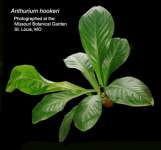
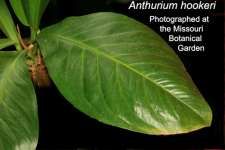
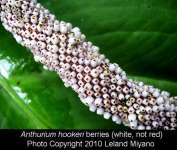
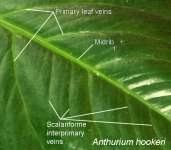

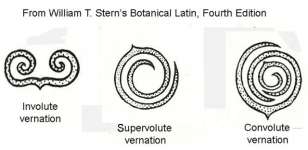
Dear Steve,
Is this A. hookeri?
http://www.wschowa.com/abrimaal/araceum/anthurium/hookeri.htm
Marek
| HTML +More | |
----- Original Message -----
From: ExoticRainforest
To: Discussion of aroids
Sent: Friday, June 11, 2010 2:21 AM
Subject: [Aroid-l] Does anyone grow the real Anthurium hookeri?
I have been seeking a specimen of the real Anthurium hookeri for years! Before you immediately respond and say yes, please look at the photos and read the descriptions in this thread. The majority of plants sold in Florida are not the true species known to science as Anthurium hookeri. but instead a plant using the name as a common name. This plant appears to be far rarer than many of us believe. It is found largely in the windward islands of the Caribbean but also in French Guiana and other countries including Venezuela. I've talked several times to Joep Moonen in French Guiana about it and he sees it rarely.
Few people appear to be able to give a good reason why almost everyone in Florida thinks they are growing Anthurium hookeri in their yard when they are not. Well known IAS member and commercial aroid grower Denis Rotolante in Homestead offered the best reason I have been able to find, "As many nurserymen down here know, Anthurium hookeri is a catch all name applied to all bird nest type Anthuriums regardless of true taxonomic origins." Many of those hybrid plants sold in Florida appear to be more closely related to Anthurium schlechtendalii or Anthurium plowmanii than to
Anthurium hookeri.
If you believe you are growing Anthurium hookeri and your plant matches the photos and information in this thread I know for certain there are other growers that want to find it, including me!
The first two photo shows a specimen of the true Anthurium hookeri photographed at the Missouri botanical Garden. Look closely at the leaves and
veins.
One of the most distinctive characteristics of the true Anthurium hookeri is it does not produce red berries as is commonly believed on the internet and many plant forums. The berries of the true species are white.
Virtually all the information on the Internet stating the berries are red is inaccurate. I even found one noted garden showing a photo of an infructescence with red berries. The plant referred to in all the garden site posts appears to be one of the common plants sold in Florida using the name only as a common name and not referring to the true species..
The next distinctive characteristic of Anthurium hookeri is the interprimary veins are evenly spaced similar to the rungs of a ladder. In science this even spacing is known as the venation being scalariforme.
Another important characteristic is a newly emerging leaf unfurls in a way that is not seen in other bird’s nest Anthurium species. The unusual way the new leaves of Anthurium hookeri are rolled is known as being supervolute vernation and are very unusual in most species. That term indicates the new leaves possess coils or folds in overlapping whorls. Vernation refers to the arrangement of young leaf blades and supervolute vernation is to possess a convolute arrangement in the folding or arrangement of a newly emerging leaf blade with one margin (edge) of the newly blade emerging rolled inward toward the midrib and the opposite margin rolled around the midrib o the opposite leaf f in a manner similar to the coil at the end of a conch shell.
All bird’s nest Anthurium, at least those that are members of Anthurium section Pachyneurium, produce convolute new leaves. The only difference in supervolute and convolute vernation is convolute vernation occurs when several leaves spiral with the next leaf in a module enclosed within the current leaf. I realize this is difficult to understand but look at the leaf in the photo as well as the diagram below. Look closely at the diagram of convolute vernation and you will see the second leaf inside the first leaf which is common to the way bird's nest forms unfurl. Anthurium hookeri is the only exception according to Dr. Croat. Tom once indicated he felt Anthurium hookeri could be in section Porphyrochitonium.
Another very important characteristic is the real Anthurium hookeri has tiny black dots, especially on the underside of the leaves. In science these little black dots are known as glandular punctates.
If you have real species of Anthurium hookeri please post photos and if you know where specimens of your plant can be found please post that as well.
There are several other unique characteristics found only on Anthurium hookeri and not on the hybrid or miss named plants commonly sold in Florida. If you want to learn more the information can be read here:
moz-do-not-send="true">http://www.exoticrainforest.com/Anthurium%20hookeri%20pc.html
The scientific description of Anthurium hookeri is very simple; so for anyone that may doubt the accuracy of what I am trying to explain please take a few seconds to read the actual description.
A. hookeri Kunth, Enum. pl. 3:74. 1841. Type: Schott Drawing 517 serves as the lectotype (designated by Mayo, 1982)
Epiphyte. Internodes short densely rooted; cataphylls lanceolate, 20-26 cm long, dilacerating from base. VERNATION- supervolute; Leaves rosulate; petioles triangular to D-shaped, 2-9 cm long, 1.5-1.7 cm wide; blades oblanceolate, broadest above middle, margins smooth, black glandular punctates on both surfaces, 35-89 cm long, 10-26 cm wide. Primary lateral veins 9-15 per side, free to the margin, tertiary veins extending in a more or less parallel, ladder-like fashion between the primary lateral veins (scalariform). peduncle to 47 cm long, to 5 mm dam.; spathe pale green, tinged purple, oblong, to 9 cm long, to 1.5 cm wide; spadix violet-purple, cylindroid-tapered, to 10-16 cm long, to 5-7 mm diam,; Infructescence-
berries, obovoid, whitish, to 6 mm long, to 4.5 mm wide.
I really want to find this plant so thanks very much for any help!
Steve
www.ExoticRainforest.com
_______________________________________________
Aroid-L mailing list
Aroid-L@www.gizmoworks.com
http://www.gizmoworks.com/mailman/listinfo/aroid-l
Nie znaleziono virusa w tej wiadomosci przychodzacej.
Sprawdzone przez AVG - www.avg.com
Wersja: 8.5.437 / Baza danych wirusów: 271.1.1/2931 - Data wydania: 06/11/10 06:35:00
------=_NextPart_001_01CD_01CB09E8.CACA9D90--
------=_NextPart_000_01CC_01CB09E8.CACA9D90 |
|
From: "Dave" <davemisc at lalakea.com> on 2010.06.14 at 01:05:19(21103)
I have several here in Hawai’i, that fit all the descriptions
(including the glandular punctuates), and some are setting seed right
now. Surprisingly, I picked them up at the island Lowe’s Hardware in
Kona, fairly large ones (leaves 2’ long) for less than $15 apiece. The
local grower is Novelty Greens, in Hilo.
-Dave
| HTML +More | |
From: John [mailto:criswick@spiceisle.com]
Sent: Friday, June 11, 2010 7:00 AM
To: 'Discussion of aroids'
Subject: Re: [Aroid-l] Does anyone grow the real Anthurium hookeri?
Steve,
I believe
the true A. hookeri occurs on Trinidad. This is according to what the late Dr.
Richard Howard told me when we were collecting in Grenada together. He
published the Flora of the Lesser Antilles. The species we have in Grenada, 90
miles to the north, is A. wildenovii I believe, and I have never seen A.
hookeri growing here.
It should
not be difficult to obtain seeds and seedlings of A. hookeri in Trinidad but
the airline charges a ridiculous amount to get there from Grenada.
John.
From: aroid-l-bounces@www.gizmoworks.com
[mailto:aroid-l-bounces@www.gizmoworks.com] On Behalf Of ExoticRainforest
Sent: Thursday, June 10, 2010 8:21 PM
To: Discussion of aroids
Subject: [Aroid-l] Does anyone grow the real Anthurium hookeri?
------=_NextPart_000_0048_01CB0B09.D89621C0--
--==============448679483995376269=� |
|
From: ExoticRainforest <Steve at ExoticRainforest.com> on 2010.06.14 at 01:54:56(21104)
Thanks Dave.
Steve
| HTML +More | |
On 6/13/2010 08:05, Dave wrote:
I
have several here in Hawai’i, that fit all the descriptions
(including the glandular punctuates), and some are setting seed right
now. Surprisingly, I picked them up at the island Lowe’s Hardware in
Kona, fairly large ones (leaves 2’ long) for less than $15 apiece. The
local grower is Novelty Greens, in Hilo.
-Dave
From:
John [mailto:criswick@spiceisle.com]
Sent: Friday, June 11, 2010 7:00 AM
To: 'Discussion of aroids'
Subject: Re: [Aroid-l] Does anyone grow the real Anthurium
hookeri?
Steve,
I believe
the true A. hookeri occurs on Trinidad. This is according to what the
late Dr.
Richard Howard told me when we were collecting in Grenada together. He
published the Flora of the Lesser Antilles. The species we have in
Grenada, 90
miles to the north, is A. wildenovii I believe, and I have never seen
A.
hookeri growing here.
It should
not be difficult to obtain seeds and seedlings of A. hookeri in
Trinidad but
the airline charges a ridiculous amount to get there from Grenada.
John.
From:
aroid-l-bounces@www.gizmoworks.com
[mailto:aroid-l-bounces@www.gizmoworks.com] On Behalf Of ExoticRainforest
Sent: Thursday, June 10, 2010 8:21 PM
To: Discussion of aroids
Subject: [Aroid-l] Does anyone grow the real Anthurium hookeri?
_______________________________________________
Aroid-L mailing list
Aroid-L@www.gizmoworks.com
http://www.gizmoworks.com/mailman/listinfo/aroid-l
--------------060004000904030403060507 |
|
From: ExoticRainforest <Steve at ExoticRainforest.com> on 2010.06.14 at 02:03:30(21105)
Hi Marek. I don't claim to be a taxonomist or expert but when I blew
the leaves up 300% the interprimary veins do appear to be
scalariforme. Can you see the black glandular punctates on the bottom
of the leaf? The primary vein count looks OK but Tom, David or Dylon
would be the best to determine if this pant is the species.
Steve
| HTML +More | |
On 6/11/2010 09:36, Marek Argent wrote:
Dear Steve,
Is this A. hookeri?
href="http://www.wschowa.com/abrimaal/araceum/anthurium/hookeri.htm">http://www.wschowa.com/abrimaal/araceum/anthurium/hookeri.htm
Marek
-----
Original Message -----
From:
href="mailto:Steve@ExoticRainforest.com">ExoticRainforest
To:
href="mailto:aroid-l@gizmoworks.com">Discussion of aroids
Sent:
Friday, June 11, 2010 2:21 AM
Subject:
[Aroid-l] Does anyone grow the real Anthurium hookeri?
I have been seeking a specimen of the real Anthurium
hookeri for years! Before you immediately respond and say yes,
please look at the photos and read the descriptions in this thread.
The majority of plants sold in Florida are not the true
species known to science as Anthurium hookeri. but
instead a plant using the name as a common name. This plant appears to
be far rarer than many of us believe. It is found largely in the
windward islands of the Caribbean but also in French Guiana and other
countries including Venezuela. I've talked several times to Joep
Moonen in French Guiana about it and he sees it rarely.
Few people
appear to be able to give a good reason why almost everyone in Florida
thinks they are growing Anthurium hookeri in their yard when
they are not. Well known IAS member and commercial aroid grower Denis
Rotolante in Homestead offered the best reason I have been able to
find, "As
many nurserymen down here know, Anthurium hookeri is a catch all name
applied to all bird nest type Anthuriums regardless of true taxonomic
origins." Many of those hybrid plants sold in Florida appear to
be more closely related to Anthurium schlechtendalii or Anthurium
plowmanii than to Anthurium hookeri.
If
you believe you are growing Anthurium hookeri and your plant
matches the photos and information in this thread I know for certain
there are other growers that want to find it, including me!
The
first two photo shows a specimen of the true Anthurium hookeri photographed
at the Missouri botanical Garden. Look closely at the leaves and veins.
One
of the most distinctive characteristics of the true Anthurium hookeri
is it does not produce red berries as is commonly believed on the
internet and many plant forums. The berries of the true species are
white.
Virtually
all the information on the Internet stating the berries are red is
inaccurate. I even found one noted garden showing a photo of an
infructescence with red berries. The plant referred to in all the
garden site posts appears to be one of the common plants sold in
Florida using the name only as a common name and not referring to the
true species..
The
next distinctive characteristic of Anthurium hookeri is the
interprimary veins are evenly spaced similar to the rungs of a ladder.
In science this even spacing is known as the venation being
scalariforme.
Another
important characteristic is a newly emerging leaf unfurls in a way
that is not seen in other bird’s nest Anthurium species.
The unusual way the new leaves of Anthurium hookeri
are rolled is known as being supervolute vernation and
are very unusual in most species. That term indicates
the new leaves possess coils or folds in overlapping whorls. Vernation
refers to the arrangement of young leaf blades and supervolute
vernation is to possess a convolute arrangement in the folding or
arrangement of a newly emerging leaf blade with one margin (edge) of
the newly blade emerging rolled inward toward the midrib and the
opposite margin rolled around the midrib o the opposite leaf f in a
manner similar to the coil at the end of a conch shell.
All bird’s nest Anthurium,
at least those that are members of Anthurium section
Pachyneurium, produce convolute new leaves. The only
difference in supervolute and convolute vernation is convolute
vernation occurs when several leaves spiral with the next leaf in a
module enclosed within the current leaf. I realize this is difficult to
understand but look at the leaf in the photo as well as the diagram
below. Look closely at the diagram of convolute vernation and you will
see the second leaf inside the first leaf which is common to the way
bird's nest forms unfurl. Anthurium hookeri is the only
exception according to Dr. Croat. Tom once indicated he felt Anthurium
hookeri could be in section Porphyrochitonium.
Another very
important characteristic is the real Anthurium hookeri has
tiny black dots, especially on the underside of the leaves. In science
these little black dots are known as glandular punctates.
If you have real
species of Anthurium hookeri please post photos and if you know
where specimens of your plant can be found please post that as well.
There are
several other unique characteristics found only on Anthurium hookeri
and not on the hybrid or miss named plants commonly sold in Florida. If
you want to learn more the information can be read here:
href="http://www.exoticrainforest.com/Anthurium%20hookeri%20pc.html"
moz-do-not-send="true">http://www.exoticrainforest.com/Anthurium%20hookeri%20pc.html
The scientific
description of Anthurium hookeri is very simple; so for anyone
that may doubt the accuracy of what I am trying to explain please take
a few seconds to read the actual description.
class="MsoNormal">A.
hookeri
Kunth, Enum. pl. 3:74. 1841. Type: Schott Drawing 517 serves as the
lectotype (designated by Mayo, 1982)
Epiphyte. Internodes short
densely rooted; cataphylls lanceolate, 20-26 cm long, dilacerating from
base. VERNATION- supervolute; Leaves rosulate; petioles triangular to
D-shaped, 2-9 cm long, 1.5-1.7 cm wide; blades oblanceolate, broadest
above middle, margins smooth, black glandular punctates on both
surfaces, 35-89 cm long, 10-26 cm wide. Primary lateral veins 9-15 per
side, free to the margin, tertiary veins extending in a more or less
parallel, ladder-like fashion between the primary lateral veins
(scalariform). peduncle to 47 cm long, to 5 mm dam.; spathe pale
green, tinged purple, oblong, to 9 cm long, to 1.5 cm wide; spadix
violet-purple, cylindroid-tapered, to 10-16 cm long, to 5-7 mm diam,;
Infructescence- berries, obovoid, whitish, to 6 mm long, to 4.5 mm
wide.
I really want to
find this plant so thanks very much for any help!
Steve
href="http://www.ExoticRainforest.com">www.ExoticRainforest.com
_______________________________________________
Aroid-L mailing list
Aroid-L@www.gizmoworks.com
http://www.gizmoworks.com/mailman/listinfo/aroid-l
Nie znaleziono virusa w tej wiadomosci przychodzacej.
Sprawdzone przez AVG - www.avg.com
Wersja: 8.5.437 / Baza danych wirusĂłw: 271.1.1/2931 - Data wydania:
06/11/10 06:35:00
_______________________________________________
Aroid-L mailing list
Aroid-L@www.gizmoworks.com
http://www.gizmoworks.com/mailman/listinfo/aroid-l
--------------070805070802080306080609 |
|
From: Ferenc Lengyel <feri.lengyel at gmail.com> on 2010.06.14 at 11:06:31(21106)
Marek,
I guess, that without the berries it is not possible to tell if a plant is the real A. hookeri. I have a plant bought as A. hookeri which shows all the features (scalariform veins, black punctuations), but its berries were not white (the pic of the infructescence can be seen here):
http://www.flickr.com/photos/lengyelf/4274882726/sizes/o/
So it is a Holland hybrid :(
The good thing is, that the germination rate is nearly 100% and the berries can be stored for several days (a few weeks) without the seeds loosing their viability significantly. But I don't know if it applies to the species itself too.
Ferenc
| HTML +More |
--0015174c188e312dd30488fb7ba6--
--==============‡78013483031212373=� |
|
From: <exotics at hawaii.rr.com> on 2010.06.16 at 05:50:41(21109)
Hi Steve,
I wrote to you last year and sent you photos that you used on your web site of the A. hookeri(true species) I am growing. Did you forget or do you feel this is not the true species???
Windy
| +More |
---- ExoticRainforest wrote:
> _______________________________________________
> Aroid-L mailing list
> Aroid-L@www.gizmoworks.com
> http://www.gizmoworks.com/mailman/listinfo/aroid-l
_______________________________________________
Aroid-L mailing list
Aroid-L@www.gizmoworks.com
http://www.gizmoworks.com/mailman/listinfo/aroid-l
|
| |
Note: this is a very old post, so no reply function is available.
|
|














